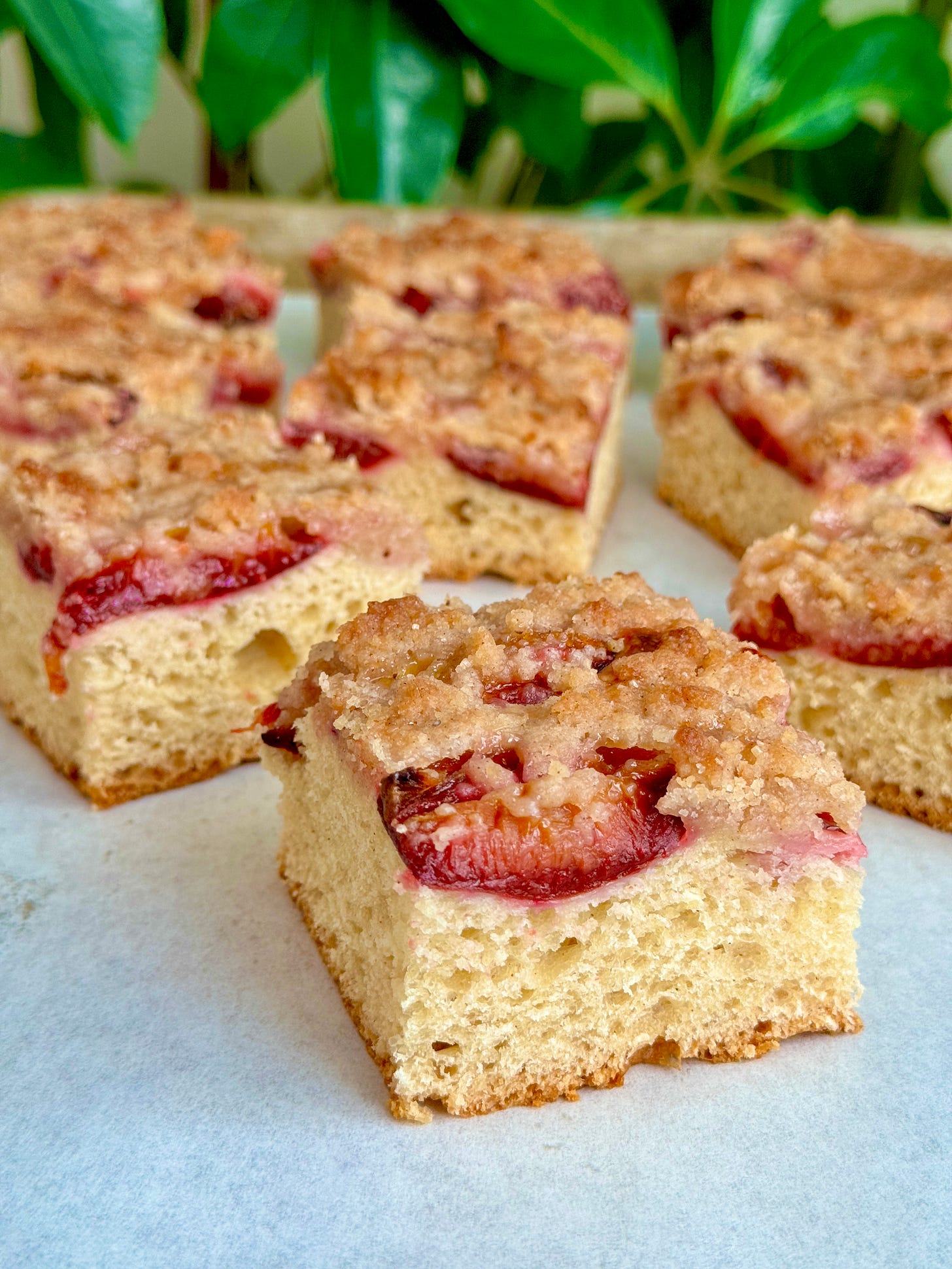German plum cake
aka Pflaumenkuchen
We used to have a plum tree and an apple tree in our backyard in Husum, both of which produced an abundance of fruit every year. I’m convinced that part of that bounty was thanks to the sheer amount of rain we got while living in that small town in northern Germany. The city’s tagline? “Husum: die graue Stadt am Meer,” which translates to “the grey town by the grey sea.” That line, taken from a poem by Theodor Storm as a love letter to the city, is even printed on most of their tourism swag—and they aren’t kidding. When I visited last October for the first time in 23 years, it rained nine out of the ten days we were there.
But I digress. While I loved the apples, the plums really captured my heart. They were so beautiful to look at with their shimmering, dark purple skin, and were so tart and crunchy to bite into. I loved how easily the pits were freed from the plums, and we’d toss them into the garden compost, hoping that another plum tree would magically sprout for next year.
Our plum harvest would fill every basket, bowl, and container in the house. Our dinner table? Completely lost beneath a sea of freshly picked plums. Needless to say, baking with plums became an annual summer tradition that I look back on with nostalgia.
Kuchen - what’s in a name?
In German, kuchen translates to cake and can refer to any kind of cake: snacking cakes, layered cakes, rolled cakes, filled cakes—you name it. But here in North America, I’ve noticed we mostly use kuchen to describe a soft, slightly yeasted cake, often filled with vanilla pudding or pastry cream.
Today, I’m sharing my recipe for Pflaumenkuchen, a German plum cake. It’s the same recipe my mom and I used to bake, which we learned from my godmother in Germany. Growing up in Northern Germany, we called it Pflaumenkuchen - pflaume for plum, kuchen for cake. Easy enough, right? Though depending on where you are in Germany, it might also be called Zwetschgenkuchen or Quetschekuche. The German language is a tongue twister all in itself.
Since I’m now thousands of miles away from my little plum tree in Husum, I look to Ontario blue plums to satisfy my craving for this yeasted cake: soft crumb, with juicy, tart plums and topped with crunchy, lightly spiced streusel.

Pflaumenkuchen
This cake is best devoured within 24 hours. While it’s delicious after cooling, I find it tastes even better the next day, as the plums soak into the cake more while the topping still stays crisp. I cover the cake and leave it at room temperature for a day. After that, if there are any slices left, I’ll refrigerate the rest—but historically, that’s never been necessary for me.
Recipe notes
If you bake the cake until the top is golden brown, you risk overbaking the yeasted cake. I solve that problem by finishing the cake with a quick stint under the broiler. Don’t walk away during this part - the broiler is mighty and works fast.
I bake this cake in a 9” square tin, but you can also use a 9” round pan. If you go smaller, like an 8” pan, you’ll get a higher cake-to-plum-and-streusel ratio, which will still taste great—just be sure to bake it a little longer.
If you double the recipe, use a jelly roll pan or half sheet pan to feed a crowd. Adjust your cake size based on how many plums you have!
Ingredients:
750 g (1 1/2 lbs) Ontario Blue or Italian plums, or whatever local plums are in season for you
250 g all-purpose flour
7 g (2 1/4 tsp) instant yeast
100 g sugar
1 tsp Kosher salt (I use Diamond Crystal Kosher)
115 ml warm milk (plus more if needed)
75 g melted butter
1 large egg
1 tsp vanilla
1 tsp ground cinnamon
For the streusel topping
60 g all-purpose flour
50 g granulated sugar
50 g brown sugar
1 tsp ground cinnamon
1/2 tsp ground cardamom
70 g room temperature butter
optional: sprinkle some coarse sugar on top for extra crunch
Instructions
Mix the dry ingredients: In a stand mixer bowl, combine flour, yeast, sugar, and salt.
Add the wet ingredients: Pour in warm milk, melted butter, egg, and vanilla. Stir to combine, then knead with the dough hook on medium. If the dough is dry, add 2 tsp milk at a time until it comes together. Knead for 6-7 minutes. The dough will be smooth, but quite sticky, and will look more liquid than you’d imagine a yeasted dough to be. That’s what we are looking for!
First rise: Cover the bowl and let the dough rise in a warm spot for 90 minutes (I like using the oven with the light on) until not quite doubled.
Prep the plums: Wash, pit, and quarter the plums. Set them aside.
Make the streusel: In a medium bowl, mix flour, sugars, cinnamon, cardamom, and butter. Use your fingers to form a sandy, clumpy texture. Set aside.
Prep the pan: Line a 9” baking tin with parchment paper, and butter the sides.
Shape the dough: Transfer the risen dough to the baking pan. Use your fingertips to spread it evenly, to cover the entire baking pan.
Add the plums: Arrange the plums on top, overlapping as needed.
Second rise: Cover the pan and let the dough rise for another hour.
Preheat the oven: Set it to 350°F. If you are proofing the dough in the oven, take it out first!
Add the streusel: Sprinkle the streusel topping evenly over the cake. If using, sprinkle the coarse sugar over top of the streusel topping.
Bake: Bake for 35 minutes, then broil for 1-2 minutes until the top is golden. Don’t step away, and watch closely for this step.
Cool and serve: Let the cake cool for 20 minutes before slicing. Store at room temp for 24 hours, then refrigerate any leftovers.




I make Pflaumenkuchen constantly during plum season! I hope everyone reading this recipe gets in there to make it. Our recipes are so similar! I'll be trying it out, for sure. Congrats on the NEWsletter, Chi.